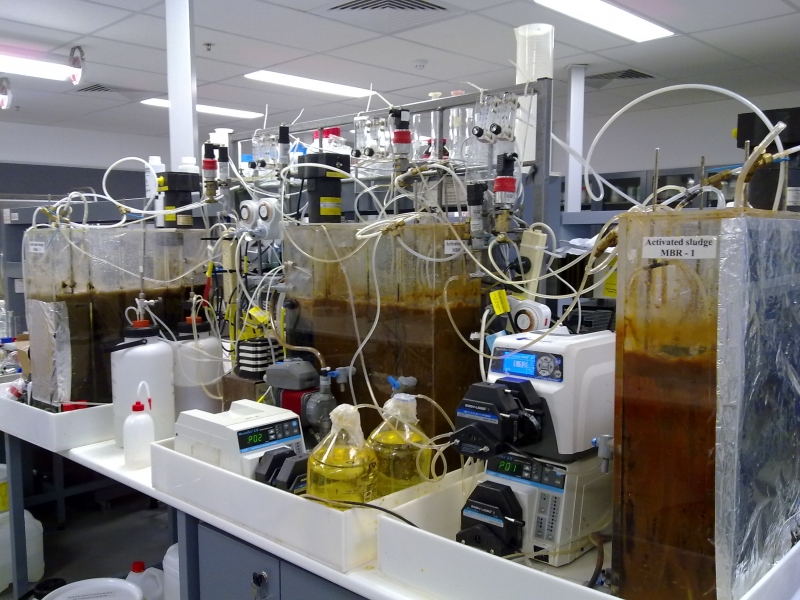Optimisation of hybrid coagulation/submerged membrane bioreactor treatment of wastewaters
Coagulant addition is used widely in both conventional and membrane-based water treatment as an essential aid to floc formation and is also recognized to assist greatly in reducing the extent of trans-membrane pressure (TMP) build-up in submerged membrane bioreactor treatment of wastewaters . Coagulant addition may also assist in removal of phosphorus in treatment of wastewaters and is also recognized to aid the dewatering of the highly gelatinous sludge that is typically produced in submerged membrane bioreactor wastewater treatment.
Despite the apparent advantages, there has been only limited investigation of the impact of coagulant choice and dosing conditions on nutrient removal, membrane fouling and excess sludge dewatering in SMBR treatment of wastewaters. One reason for the limited research undertaken to date in this area relates to the complexity of the SMBR system and the variety of reactions that can occur on addition of a coagulant to a membrane bioreactor.

Some of the unanswered questions are:
- Does the coagulant precipitate and, if so, is the major form an oxide or phosphate solid?
- Do these solids transform to more crystalline entities over time?
- If, rather, the coagulant initially forms dissolved complexes with the organic matter present, how stable are these complexes?
- If Fe(III) salts are added to the anoxic chamber, is iron reduced to Fe(II) species?
- On transport to the aerated chambers, does Fe(II) oxidise and, if so, what are the oxidation products?
The objective of this project is to improve nutrient removal, minimise membrane fouling and aid the dewatering of excess sludge in hybrid coagulation/submerged membrane bioreactor (MBR) treatment of wastewater by:
- Experimental examination of the impact of coagulant addition on SMBR performance and
- Kinetic modelling of key coagulant transformation processes within the SMBR.
Judicious use of both laboratory-based and pilot-scale experimentation using both synthetic and real wastewaters coupled with advanced mineral characterisation techniques (EXAFS, SAED, HRTEM) combined with systems-based kinetic modelling will assist greatly in elucidating the key processes operating in hybrid coagulation/submerged membrane bioreactor (C/SMBR) systems.
The project commenced in July 2010. A wide range of coagulant dosing
conditions were tested using three small scale membrane bioreactors located at UCMST and one pilot scale MBR at Sydney Water’s Bondi Sewage Treatment Plant.
Upon the completion in 2014, the project succesfuly derived operating protocols for membrane bioreactors that allow the development of cost effective operating methods. Novel cleaning strategies that are far more effective than traditional cleaning protocols used in MBR plants have also developed.
Research Team: David Waite
Greg Leslie
Yuan Wang
Zhenghua (Jacky) Zhang (APAI funded PhD student)
Xuefei (Sophie) Liu (APAI funded PhD student)
Collaborators: Beijing Origin Water Technology
Tsinghua University
Sydney Water
Water Research Australia
Funding Body: ARC Linkage Grant LP100100056
Publications:
- Wang Y; Leslie GL; Waite TD, 2014, 'Impact of iron dosing of membrane bioreactors on membrane fouling', Chemical Engineering Journal, vol. 252, pp. 239 - 248, http://dx.doi.org/10.1016/j.cej.2014.04.106
- Wang Y; Tng KH; Wu H; Leslie G; Waite TD, 2014, 'Removal of phosphorus from wastewaters using ferrous salts - A pilot scale membrane bioreactor study', Water Research, vol. 57, pp. 140 - 150, http://dx.doi.org/10.1016/j.watres.2014.03.029
- Liu X; Wang Y; Waite TD; Leslie G, 2016, 'Fluid Structure Interaction analysis of lateral fibre movement in submerged membrane reactors', Journal of Membrane Science, vol. 504, pp. 240 - 250, http://dx.doi.org/10.1016/j.memsci.2015.12.056
- Wu H; Ikeda-Ohno A; Wang Y; Waite TD, 2015, 'Iron and phosphorus speciation in Fe-conditioned membrane bioreactor activated sludge', Water Research, vol. 76, pp. 213 - 226, http://dx.doi.org/10.1016/j.watres.2015.02.020
- Liu X; Wang Y; Waite TD; Leslie G, 2015, 'Numerical simulation of bubble induced shear inmembrane bioreactors: Effects of mixed liquor rheology and membrane configuration', Water Research, vol. 75, pp. 131 - 145, http://dx.doi.org/10.1016/j.watres.2015.02.009
- Zhang Z; Wang Y; Leslie GL; Waite TD, 2015, 'Effect of ferric and ferrous iron addition on phosphorus removal and fouling in submerged membrane bioreactors', Water Research, vol. 69, pp. 210 - 222, http://dx.doi.org/10.1016/j.watres.2014.11.011
- Xin Y; Bligh MW; Kinsela AS; Wang Y; Waite D, 2015, 'Calcium-mediated polysaccharide gel formation and breakage: Impact on membrane foulant hydraulic properties', Journal of Membrane Science, vol. 475, pp. 395 - 405, http://dx.doi.org/10.1016/j.memsci.2014.10.033
- Zhang Z; Bligh MW; Wang Y; Leslie GL; Bustamante H; Waite TD, 2015, 'Cleaning strategies for iron-fouled membranes from submerged membrane bioreactor treatment of wastewaters', Journal of Membrane Science, vol. 475, pp. 9 - 21, http://dx.doi.org/10.1016/j.memsci.2014.09.003
For more information, contact us at yuan.wang@unsw.edu.au
